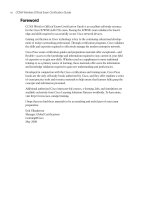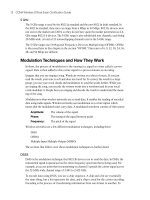CCNA Wireless Official Exam Certification Guide part 10 pps
Bạn đang xem bản rút gọn của tài liệu. Xem và tải ngay bản đầy đủ của tài liệu tại đây (116.96 KB, 10 trang )
62 CCNA Wireless Official Exam Certification Guide
Outdoor Mesh Networks
As you can see, bridges are a good way to connect remote sites. However, suppose that
you are operating in a point-to-multipoint topology, and the central site experiences con-
gestion. Who suffers? Just the central site? Just the remote site? No; the answer is every-
one. When two remote sites communicate through a central site, the central site makes all
the difference.
Assume that the central site goes down, as shown in Figure 4-10.
Now the remote sites can’t communicate with each other or the central site. This can be
a major issue to contend with. The solution is to deploy a mesh network such as the one
illustrated in Figure 4-11.
Site B Site CSite A
Point-to-Multipoint
Figure 4-10 Wireless Bridge Issues
LWAPP
LWAPP
LWAPP
LWAPP
LWAPP
LWAPP
LWAPP
LWAPP
LWAPP
Wireless
Mesh
Controller
Wireless
Mesh
Controller
Figure 4-11 Wireless Mesh Solution
Key
Topi
c
05_1587202115_ch04.qxd 9/29/08 2:44 PM Page 62
Chapter 4: WLAN Technologies and Topologies 63
The mesh solution is appropriate when connectivity is important, because multiple paths
can be used. The IEEE is currently working on a mesh standard (802.11s). However, the
solution discussed here is a Cisco solution in which a wireless controller, also shown in
Figure 4-11, is involved.
When you have a mesh network, some nodes (another term for APs in a mesh network)
are connected to a wired network. Some nodes simply act as repeaters. A mesh node re-
peats data to nearby nodes. More than one path is available, so a special algorithm is used
to determine the best path. The alternative paths can be used when there is congestion or
when a wireless mesh node goes down.
05_1587202115_ch04.qxd 9/29/08 2:44 PM Page 63
64 CCNA Wireless Official Exam Certification Guide
Exam Preparation Tasks
Review All the Key Topics
Review the most important topics from this chapter, denoted with the Key Topic icon.
Table 4-2 lists these key topics and the page number where you can find each one.
Definition of Key Terms
Define the following key terms from this chapter, and check your answers in the glossary:
WPAN, SIG, WLAN, IEEE, WMAN, WiMax, WWAN, GSM, CDMA, ad hoc, infrastruc-
ture, distribution system, BSS, IBSS, STA, infrastructure device, BSA, ESA, roaming, SSID,
BSSID, MBSSID, co-channel interference, WGB, aWGB, uWGB, repeater, node
Table 4-2 Key Topics for Chapter 4
Key Topic Item Description Page Number
Figure 4-1 Wireless topology overview 52
Figure 4-2 Ad hoc network 56
Figure 4-3 Basic service area 57
Figure 4-4 Extended service area 57
Figure 4-5 Wireless roaming 58
Figure 4-6 Workgroup bridge topology 59
Figure 4-7 Wireless repeater topology 60
Figure 4-8 Point-to-point wireless bridge topology 61
Figure 4-9 Point-to-multipoint wireless bridge topology 61
Figure 4-11 Wireless mesh solution 62
05_1587202115_ch04.qxd 9/29/08 2:44 PM Page 64
05_1587202115_ch04.qxd 9/29/08 2:44 PM Page 65
This chapter covers the following subjects:
Principles of Antennas: Covers antenna
concepts.
Common Antenna Types: Describes
omnidirectional and directional antennas.
Antenna Connectors and Hardware: Looks at
some of the connectors used in wireless deploy-
ments as well as other common hardware.
06_1587202115_ch05.qxp 9/29/08 2:45 PM Page 66
CHAPTER 5
Antenna Communications
Table 5-1 “Do I Know This Already?” Section-to-Question Mapping
Foundation Topics Section Questions
Principles of Antennas 1–7
Common Antenna Types 8–16
Antenna Connectors and Hardware 17–20
In any wireless network, the capability to propagate the signal is key. Without that capa-
bility, the whole concept of a wireless network falls apart. In this chapter, you will learn
about antenna principles, along with some common antenna and connector types.
You should take the “Do I Know This Already Quiz?” first. If you score 80 percent or
higher, you may want to skip to the section “Exam Preparation Tasks.” If you score below
80 percent, you should review the entire chapter.
“Do I Know This Already?” Quiz
The “Do I Know This Already?” quiz helps you determine your level of knowledge of this
chapter’s topics before you begin. Table 5-1 details the major topics discussed in this chap-
ter and their corresponding quiz questions.
1. Which of the following are types of polarization? (Choose all that apply.)
a. Ver t i c a l
b. Horizontal
c. Nautical
d. Circular
2. All Cisco antennas use what type of polarization?
a. Linear
b. Circular
c. Magnetic
d. Perpendicular
06_1587202115_ch05.qxp 9/29/08 2:45 PM Page 67
68 CCNA Wireless Official Exam Certification Guide
3. In an electromagnetic wave, where is the magnetic wave found in relation to the elec-
tric wave?
a. Parallel to the electric wave.
b. At a 45-degree angle to the electric wave.
c. Perpendicular (at a 90-degree angle).
d. There is no magnetic wave.
4. How many antennas are used with diversity?
a. Three
b. Four
c. One
d. Two
5. What does diversity listen to when choosing a better antenna to use?
a. The destination MAC address
b. The preamble
c. The data
d. The source MAC address
6. How far apart should antennas be placed when using diversity?
a. 2 meters
b. Two wavelengths
c. One wavelength
d. 1 meter
7. True or false: Two antennas using diversity can cover two areas.
a. True
b. False
8. What are the main families of antennas? (Choose all that apply.)
a. Omnidirectional
b. Unidirectional
c. Directional
d. Ya g i
9. In relation to sending a linear waveform, the horizontal plane (H-plane) is also called
what?
a. Vertical plane
b. Azimuth
c. Axis
d. Linear plane
06_1587202115_ch05.qxp 9/29/08 2:45 PM Page 68
Chapter 5: Antenna Communications 69
10. To display the coverage from top to bottom, what plane is represented?
a. A-plane
b. E-plane
c. C-plane
d. Airplane
11. The 2.2 dipole antenna is designed for what type of deployment?
a. Indoor omnidirectional
b. Indoor directional
c. Outdoor point-to-point
d. Outdoor omnidirectional
12. Which antenna is considered a “special” omnidirectional antenna?
a. AIR-ANT1728
b. AIR-ANT3338
c. AIR-ANT2485P-R
d. AIR-ANT3213
13. A yagi antenna is best used in what setting or settings? (Choose all that apply.)
a. Warehouse where multiple antennas are lined up
b. Conference room
c. Point-to-point over long distances
d. Long hallways
14. True or false: A parabolic dish antenna uses a wide RF path.
a. True
b. False
15. For mounting reasons, what can be changed on a parabolic antenna?
a. Polarity
b. Diversity
c. Shape
d. Radiation pattern
16. The AIR-ANT3213 uses how many antennas?
a. Two
b. Four
c. Six
d. One
06_1587202115_ch05.qxp 9/29/08 2:45 PM Page 69
70 CCNA Wireless Official Exam Certification Guide
17. Cisco uses which types of connectors? (Choose all that apply.)
a. SMA
b. N-connector
c. RP-TNC
d. TNC
18. To lower the amount of energy being sent to the antenna, which of the following
devices could be used?
a. Amplifier
b. Attenuator
c. Lightning arrestor
d. Fiber-patch
19. To increase the amount of energy, which of the following devices could be used?
a. Amplifier
b. Attenuator
c. Lightning arrestor
d. Fiber-patch
20. True or false: Lightning arrestors are designed to withstand a full lightning strike.
a. True
b. False
06_1587202115_ch05.qxp 9/29/08 2:45 PM Page 70
Chapter 5: Antenna Communications 71
Foundation Topics
Principles of Antennas
If someone asked you what the most important part of a wireless network is, what would
you say? I’d have to say the antenna. Why? Without it, you have a nice little AP that can
offer network services for anyone within about 3 feet. But that’s not what you want. You
want to make sure that your space is properly covered. You need antennas to do this. In
fact, you need the right antennas to do this. In this section you will learn about the factors
involved in dealing with antennas, which include polarity and diversity.
Polarization
The goal of an antenna is to emit electromagnetic waves. The electro portion of the term
electromagnetic describes the wave and that it can move in different ways. The way that it
moves is its polarization. There are three types of polarization:
■ Ver t i c a l
■ Horizontal
■ Circular
As shown in Figure 5-1, vertical polarization means that the wave moves up and down in
a linear way. Horizontal polarization means that the wave moves left and right in a linear
way.
The third type of polarization, circular polarization, indicates that the wave circles as
it moves forward, as illustrated in Figure 5-2.
The electric field is generated by stationary charges, or current. There is also a magnetic
field—hence the term electromagnetic. The magnetic field is found perpendicular (at a 90-
degree angle) to the electric field. This magnetic field is generated at the same time as the
electric field; however, the magnetic field is generated by moving charges. Cisco antennas
are always vertically polarized in wireless networks. This makes the electric field vertical.
Why is this important? The importance is that the antenna is designed to propagate sig-
nals in a certain direction. Here is where installation errors can hurt you. For example, if
you have a long tube-like antenna, it would face up/down. If you placed it flat instead, the
signal would propagate in a different direction and would end up degraded.
Although this is not a huge factor in indoor deployments, it can be in outdoor deploy-
ments. Usually other factors degrade your wireless signal propagation on indoor deploy-
ments.
Diversity
By now you should understand what the multipath issue is. Traffic takes different paths
because of the obstacles in the wireless path. One way to deal with multipath issues is to
use two antennas on one AP. Diversity is the use of two antennas for each radio to in-
crease the odds that you receive a better signal on either of the antennas.
06_1587202115_ch05.qxp 9/29/08 2:45 PM Page 71









